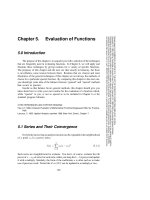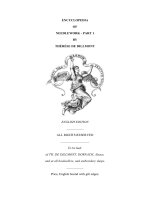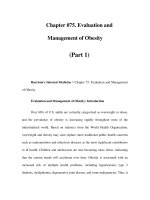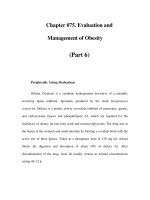THE LINGUISTICS, NEUROLOGY, AND POLITICS OF PHONICS - PART 1 docx
Bạn đang xem bản rút gọn của tài liệu. Xem và tải ngay bản đầy đủ của tài liệu tại đây (903.08 KB, 21 trang )
THE
LINGUISTICS,
NEUROLOGY,
AND
POLITICS
OF
PHONICS
Silent
"E"
Speaks
Out
THE
LINGUISTICS,
NEUROLOGY,
AND
POLITICS
OF
PHONICS
Silent
"E"
Speaks
Out
Steven
L.
Strauss
LAWRENCE
ERLBAUM
ASSOCIATES,
PUBLISHERS
2005
Mahwah,
New
Jersey
London
Copyright
©
2005
by
Lawrence Erlbaum Associates,
Inc.
All
rights reserved.
No
part
of
this book
may be
reproduced
in
any
form,
by
photostat,
microform, retrieval system,
or any
other
means, without
the
prior
written permission
of the
publisher.
Lawrence Erlbaum Associates,
Inc.,
Publishers
10
Industrial Avenue
Mahwah,
New
Jersey 07430
The
quoted
material
at the
beginning
of
each part
of the
book
is
taken from
the
following
sources:
Part
I:
Dickens,
C.
(1961).
Hard
times.
New
York:
New
American Library.
Part
II:
Einstein,
A.
(1954).
Ideas
and
opinions.
New
York: Wings Books. (Reprinted
from
The
New
York
Times,
p. 37,
1952,
October
5)
Part
III:
Dante,
A.
(1949).
The
divine
comedy
1:
Hell
(D. L.
Sayers, Trans.).
London:
Penguin
Books. (Original work published
1314)
Part
IV:
Sheehan,
H.
(1993).
Marxism
and the
philosophy
of
science:
A
critical
history.
Atlantic High-
lands,
NJ:
Humanities Press International. (Original work published
1985)
Some
of the
material
in the
book
was
reworked from
the
following
sources
and
appears
with
permission
of the
publishers:
Strauss,
S. L.
(2003, February). Challenging
the
NICHD reading research
agenda.
Phi
Delta
Kappan,
438-442.
Strauss,
S. L.
(2000, November).
The
politics
of
reading
and
dyslexia.
Z
Magazine,
pp.
48—53.
Strauss,
S. L.
(1999, January). Phonics, whole language,
and
H.R. 2614.
Z
Magazine,
pp.
46-50.
Altwerger,
B., &
Strauss,
S. L.
(2002).
The
business behind testing.
Language
Arts,
256-262.
Cover
design
by
Kathryn Houghtaling Lacey
Library
of
Congress
Cataloging-in-Publication Data
The
Linguistics, Neurology,
and
Politics
of
Phonics: Silent
"E"
Speaks
Out,
by
Steven
L.
Strauss
ISBN
0-8058-4743-X (cloth
:
alk.
paper)
—
ISBN
0-8058-5244-1
(pbk.
:
alk.
paper).
Includes bibliographical references
and
index.
Copyright information
for
this volume
can be
obtained
by
contacting
the
Library
of
Congress.
Books
published
by
Lawrence Erlbaum Associates
are
printed
on
acid-free
paper,
and
their bindings
are
chosen
for
strength
and
durability.
Printed
in the
United States
of
America
1 0
98765432 1
To
my
mother Selma Strauss,
and to the
loving
memory
of
my
father
Seymour
Strauss
Contents
Foreword
by
Richard
L.
Allington
ix
Preface
xiii
Table
of
Phonetic Characters
xix
I:
THE
PROBLEM:
AN
ALLEGED
LITERACY
CRISIS
1
1 The
Literacy Crisis According
to
Corporate America
3
2
Corporate
America's Education Reform
17
3
Political Support
of the
Corporate Agenda
23
4
Media Complicity
in
Promoting Neophonics
30
II:
THE
NEOPHONICS SOLUTION:
A
CASE
OF
CONTEMPORARY
PSEUDOSCIENCE
35
5 The
Variety
of
Scientific Methodologies
37
6
Problems With
the
Alphabetic Principle
57
vii
Vlll
CONTENTS
7
Functional Neuroimaging
and the
Image
of
Phonics
73
III:
RECLAIMING
THE
SCIENCE
OF
PHONICS
93
8
Three
Definitions
of
Phonics
95
9 The
Principle
for
Competing Phonics Rules
105
10
Theoretical Implications
of
r-Controlled Vowels
118
11 The
Phonics
of
Silent
e 129
12 The
Naturalness
of
Exceptions
to
Phonics Rules
135
13
Applications
of
Scientific Phonics
145
IV:
DEFENDING SCIENCE
AND
DEMOCRACY
AGAINST
NEOPHONICS
157
14 The
Neophonics Counterrevolution
in
Science
159
15
Academic Imperialism Versus Academic Freedom
175
Postscript:
A
Formal Approach
to
Phonics
186
References
190
Author Index
197
Subject
Index
201
Foreword
Richard
L.
Allington
University
of
Florida
I'll
bet
Steve Strauss
and I
wouldn't
wholly
agree
on
just
what constitutes
an
"ideal" instructional plan
for
developing children's reading proficiencies.
I'll
bet our
plans would diverge
in the
area
of
children's decoding develop-
ment. Nonetheless,
we
both agree that
the
legislation
and
mandates
en-
dorsed
by
entrepreneurial
neophonics
advocates reflect little
of the
sub-
stantial
empirical evidence concerning
effective
literacy instruction
and
even
less
of
what
scientific
research
has
documented about
how
best
to
teach children
to
read proficiently. Their recommendations
for
developing
children's decoding proficiencies
fail
not
just
to
reflect
the
broad
scientific
evidence
but
also
to
reliably represent
the
even epistemologically
and
methodologically narrow findings
of the
National Reading Panel (Alling-
ton,
2002;
Garan, 2002; Foorman
&
Fletcher, 2003; Shanahan, 2001,
2002,
2003;
Yatvin,
2003).
Although most teachers (and probably most school administrators,
teacher educators,
and
researchers) have
not
read
the
full
NRP
report,
and
so
generally
fail
to
recognize
the
systematic misrepresentations
of the
find-
ings
of
that
flawed
report
(Camilli, Vargas,
&
Yurecko, 2003; Coles, 2003;
Cunningham,
2001), they
do
recognize that much
of the
current advice
of-
fered
by the
entrepreneurial neophonics advocates contradicts
the
profes-
sional
wisdom that accumulates
as a
result
of
instructional experience.
They
recognize that, when
the
federal government distributes
a
document
suggesting that independent reading
at
school
is not
supported
by
science
but
that
independent
reading
at
home
is
(Armbruster, Lehr,
&
Osborn,
2001),
something
is
awry.
When this same document
offers
criteria
for
"sci-
entific"
reading programs, criteria based more
in
ideology than
in
evidence
ix
X
FOREWORD
(Allington,
2002),
teachers
may
wonder just what sort
of
science could
in-
vent
such criteria.
Likewise,
when policy mandates
the use of a
scripted
one-size-fits-all
read-
ing
program,
teachers
wonder
how
anyone
who
raised
even
a
single
child
could imagine that children
do not
differ
in
their development
and
their
in-
structional needs. These teachers
may not be
familiar
with
a
century
of re-
search
showing that "proven" programs
are
among
the
most antiscientific
ideas
ever
promoted,
but
they
do
know that children
differ
and so too
must
the
literacy instruction they receive. Some kids come
to
literacy
with
relatively
little
effort
or
anxiety, whereas others struggle. Some kids
need
less instruc-
tional attention, others
need
more,
and
some need much, much more. This
should
be
considered
the
normal state
of
affairs.
In
every
human
proficiency,
deviation
from
"normal" development
is
expected. Whether
we
look
at ice
skating,
cello playing, video gaming, written composition, figure drawing,
mathematical computation, spelling, pseudoword-decoding speed,
or
rapid
automized naming
of
random objects, children
differ.
Even
given
the
same
quantity
and
quality
of
instruction
on any of
these tasks, children
still
differ
in
how
easily
or
quickly
they develop proficiency.
I
worry about
the
current emphasis
on
stigmatization
of
children
who
find
learning
to be
literate more
difficult.
How
else
is a
struggling child
to
feel
when
left
behind
in
third
grade
because
his
performances
failed
to
meet
an
arbitrary institutional standard, when
he
fails
day
after
day in
that
mandated
one-size-fits-all reading program?
Every
parent
(and teacher) knows
how
important motivation
is to ac-
complished performances.
And
they know
how
important success
is to mo-
tivation
(Pressley
et
al., 2003). Being dubbed
a
reading
failure
daily works
against
ever marshalling
the
effort
needed
to
become accomplished
at
liter-
acy.
But
dubbing children (and their teachers) failures seems
the
current
policy
theme.
So
what
is a
teacher
(or
principal,
teacher
educator, researcher,
or
par-
ent)
to do?
Jules
Henry (cited
in
Kohl, 2003) argued
for
three
forms
of
sanity.
In the
first
form,
one
believes
the
sham
is the
truth. Perhaps
out of
igno-
rance
or
naivete
or
ideological bias,
a
sham simply isn't recognized
as a
sham.
In
the
second form,
we see
through
the
sham
but
decide
to let it
ride
and
go
along with
it, all the
while recognizing
the
sham
for
what
it is. In
this case
we
go
along with
the
sham when airport security demands
a
young mother
drink
from
the
baby's bottle
of
milk before being allowed
to
pass into
the
boarding
area
(you never know what
the
white
milky
stuff
might really be!),
or
when grandma
is
allowed
to
bring
her
plastic knitting needles
on
board
but
not her
aluminum
ones.
In the
final
form,
we see
through
the
sham
and
fight
against
it as
best
we
can.
For
teachers this might include ignoring mandates.
For
school admin-
istrators this might result
in
rejecting state
or
federal monies
with
too
many
XI
FOREWORD
strings
attached
(as a
number
of
schools across
the
country have
done
in re-
jecting available Reading First funding).
For
teacher educators
it
might
be
documenting
for
education students
the
breadth
of the
fraud being perpet-
uated
as
scientifically
based reading. Researchers, however, write books
and
articles
about
the
fraud, which brings
us to
this eloquent
and
important
book written
by
neurologist Steven Strauss.
Given
the
complexity
of the
topics Strauss writes about (democracy,
eco
nomics,
geneticism, neurology, linguistics, aphasia),
I was
surprised that
I
understood
most
of it and
enjoyed reading
all of it. My
students understood
and
enjoyed
the
chapters
I
distributed
to
them
for
course readings.
The
breadth
of
this book
is its
single most striking feature. With discussions
of
academic imperialism, high-stakes testing, federalized education mandates,
media complicity, Lysenkoism,
MRI
imaging,
the
antiscientific neophonics
movement
with
its
entrepreneurial promotion
of
mind-numbing
skill
and
drill commercial kits
and
packages, this book cuts
a
broad
swath through
current educational
fads
and the
pseudosciences
and
political
and
eco-
nomic forces that sustain
the
fads.
The
clear, concise,
and
powerful
chapters
on the
pseudoscience that
un-
derlies
the
recent instructional mandates represent
a
major contribution
to
the
education profession.
Here
Strauss illustrates
just
how
uninformed
many
researchers
are
about
the
relational
and
marking rules
of the
English
alphabetic system,
so
uninformed that they
are
unable
to
construct
a
reli-
able
set of
words
to
test their theories about decoding acquisition. They
are
so
narrow
in
their training
and
worldview that they seem
wholly
unaware
of
the
limited
and
parochial nature
of
their
views
of
science generally,
and the
science
of
literacy acquisition
specifically.
To
paraphrase Harvard scholar Richard Elmore
(2002),
the
current fed-
eral reading policy
(I say
"reading policy" because writing, thinking, speak-
ing,
and
listening have
all
been somehow
left
behind)
is
based
on
little
more than ideological gossip among people
who
know hardly anything
about
the
institutional realities
of
classrooms
and
even less about
the
prob-
lems
of
improving instruction
in
schools. Strauss reminds
us
that
we
know
better
(or
should)
and he has
elected
the
third form
of
sanity,
resistance.
I
hope
this book finds
the
wide audience
it
deserves.
I
hope
it
moves
more
folks
to
elect that third
form
of
sanity
and
begin
to use
both science
and the
professional wisdom
to
work
to
bring America's children truly evi-
dence-based literacy instruction.
REFERENCES
Allington,
R. L.
(2002).
Big
brother
and the
national
reading curriculum:
How
ideology
trumped
evi-
dence.
Portsmouth,
NH:
Heinemann.
xii
FOREWORD
Armbruster,
B.,
Lehr,
F., &
Osborn,J.
(2001).
Put
reading
first.
Washington,
DC:
National
Insti-
tute
for
Literacy.
Camilli,
G.,
Vargas,
S., &
Yurecko,
M.
(2003).
Teaching
children
to
read:
The
fragile
link
be-
tween
science
and
federal education policy.
Education
Policy
Analysis
Archives,
ll(15)
[On-
line]. Available:
a/vllnl5/
Coles,
G.
(2003).
Reading
the
naked
truth:
Literacy,
legislation,
and
lies.
Portsmouth,
NH:
Heinemann.
Cunningham,J.
W.
(2001).
The
National Reading Panel
report.
Reading
Research
Quarterly,
30,
326-335.
Elmore,
R. F.
(2002, Spring). Unwarranted intrusion.
Education
Next
[On-line]. Available:
Foorman,
B., &
Fletcher,
J.
(2003). Correcting
errors.
Phi
Delta
Kappan,
84,
719.
Garan,
E.
(2002).
Resisting
reading
mandates:
How to
triumph
with
the
truth.
Portsmouth,
NH:
Heinemann.
Kohl,
H. R.
(2004).
Stupidity
and
tears.
New
York:
New
Press.
Pressley,
M.,
Dolezal,
S. E.,
Raphael,
L. M.,
Mohan,
L.,
Roehrig,
A. D., &
Bogner,
K.
(2003).
Motivating
primary
grade
students.
New
York:
Guilford Press.
Shanahan,
T.
(2001). Response
to
Elaine Garan.
Language
Arts,
79,
70-71.
Preface
In
this book
I
explore
the
driving forces behind
the
current government-
sponsored resurrection
of
phonics,
and the
arguments used
to
justify
its le-
gal
sanctification.
I
show that
one
thing
is
absolutely clear: Politics
has
taken
precedence over science,
and
over common sense
as
well.
Teachers
and
students today
are
under immense pressure, with ord-
nance
falling
from
the
very
highest levels
of
government.
As
Washington
pushes
to
consolidate
its
control over classroom curriculum, especially
in
the
area
of
reading instruction, teachers
and
students
are
feeling
the
con-
straints
tighten around their
own
independent thinking, creativity,
and
self-
expression.
The
mutually invigorating joys
of
teaching
and
learning
are
suf-
focating
from
the
smoke
of
burned-out teachers
and
learners.
To
advance
its
agenda
for
reading
and
reading instruction, Washington
has
legislated
a
self-serving
definition
of
science.
It
would appear that this
definition
has
guided
phonics
into
center
stage
in
elementary school class-
rooms,
and
kicked meaning-centered approaches
to
reading
off
stage.
In
truth, though,
as
shown
in
this book,
the
government's distorted
view
of
sci-
ence
was
carefully
concocted
in
order
to
justify
an
already-made commit-
ment
to the
resurrection
of
phonics, even
after
decades
of
meaning-cen-
tered
research
had
demonstrated
its
profound limitations.
The new
phonics,
or
what
I
prefer
to
call
neophonics,
is a
central compo-
nent
of the
government's
new
curriculum. However,
it did not
arise
in a
vacuum,
and
would wither
away
overnight without
the
dual escorts
of law
and
coercion, popularly referred
to as
high-stakes
testing
and
accountability.
Might
makes right
in the field of
science,
and it is the
political right that
fashions
the
might.
Xlll
XIV
PREFACE
Under
various undemocratically imposed accountability maneuvers,
teachers
are now
pressured into using state-approved, commercial phonics
materials,
whether they
agree
with
them
or
not.
At the
same time, they
are
being intimidated against using more authentic, meaning-centered materi-
als,
even when their professional judgments
are on the
side
of
real litera-
ture,
written language
as
communication,
and the
cultivation
of
critical
thinking
in
their students.
Students
are
being tested
at
younger
and
younger ages,
as
precious
class
time
that should
be
used
for
meaningful curriculum gives
way to
test prepa-
ration. Parents
are
caught between
the
promise
of a
rosy
economic
future
for
a
child
who
scores
high
in the new
curriculum,
and the
reality
of
height-
ened
anxiety, competitiveness, jealousy,
and
suspicion.
The
reality
has not
yet
hit
home that, given
the
same economic system,
the
future
will
be no
less
insecure than
it
already
is, no
matter
how
well
children master phonics.
In
this book
I
show
how
phonics
is one
element
of a
larger political pro-
gram
to
remake
the
U.S. labor
force,
to
equip
the
next generation
of
work-
ers
with
those "21st-century literacy
skills"
that corporate America sees
as vi-
tal to its own
survival. This
is
corporate America's
own
"literacy crisis,"
which,
true
to
historical
form,
it is
trying
to
hand
off to
working people
as
their
crisis.
This
crisis,
we are
told,
is not
corporate America's
own
insecurity
about
maintaining short-
and
long-term profit-making capabilities,
but
rather,
the
next generation
of
workers' potential inability
to find
decent
jobs
if
they
do not
become better readers. "Raising academic standards
will
help your child succeed
in
today's increasingly competitive world," chimes
the
CEOs
of the
nation's largest corporations (Business Roundtable, 1998a,
par.
2).
Corporate America claims
it is
doing working America
a
favor,
whipping students into line
for
their
own
good.
But
phonics itself
is not the
brainchild
of
corporate America.
It is the so-
lution
to
corporate America's
own
literacy crisis that
has
been
offered
to it
by
certain politically well-positioned reading personalities
and
scientists.
Still, only
corporate
America's
extreme
sense
of
urgency
regarding
its
bat-
tle
with
overseas competitors,
and its
perception that winning this battle
re-
quires
a new
type
of
labor
force,
can
explain
the
aggressiveness
with
which
phonics
has
been dumped onto
the
laps
of
teachers
and
students.
Important critiques
of the
government's politicized phonics agenda
have
been
on
bookshelves
for
several years. Among these
are
Richard
L.
Arlington's
Big
Brother
and the
National
Reading
Curriculum:
How
Ideology
Trumped
Evidence
(2002);
Gerald Coles'
Misreading
Reading:
The Bad
Science
that
Hurts
Children
(2002)
and
Reading
the
Naked
Truth:
Literacy,
Legislation,
and
Lies
(2003); Elaine Garan's
Resisting
Reading
Mandates:
How to
Triumph
With
the
Truth
(2002); Richard
J.
Meyer's
Phonics
Exposed:
Understanding
and
Resisting
Systematic
Direct
Intense
Phonics
Instruction
(2001);
and
Denny
PREFACE
XV
Taylor's Beginning
to
Read
and the
Spin
Doctors
of
Science:
The
Political
Cam-
paign
to
Change
America's
Mind
About
How
Children
Learn
to
Read
(1998).
Critiques
of
phonics
itself,
understood
as a
coherent system
of
letter-
sound correspondences that purportedly
plays
an
essential role
in
read-
ing, have also been available, including
Ken
Goodman's important
Phonics
Phacts
(1993). Together, these essential works take
the
federal govern-
ment
to
task
in
exposing
the
faulty
science, vested financial interests,
and
public relations gimmicks that have created
the new
phonics.
The
present
work
is
intended
as a
contribution
to
this emerging genre.
It
examines
the
roles played
by
three
key
actors—corporate America, politicians,
and
state-supported reading researchers—in
the
formulation
of the
neophon-
ics
political program.
The
book
documents
how
these
actors have
entered
into
a
relationship
of
embedded subservience.
The
scientists seek
to
satisfy
the
demands
of the
politicians,
and the
politicians
do the
same
for
corporate America.
At
each
level,
of
course, there
are
individuals
who
only
see the
virtues
and
benefits
of
their
own
work, sincere scientists,
for
example,
who are
oblivious
to any
ulterior directives emanating
from
above.
But the
facts
of the
matter
are
what
they are:
It is not by
coincidence that those scientific theories
of
read-
ing
that have serious problems
with
intensive phonics
are
just
not
drinking
from
Washington's funding fountain.
In the
course
of
analyzing
neophonics
as a
political program,
I
also inves-
tigate
its
alleged
scientific
bases. Proponents
of
neophonics have claimed
that only phonics-based instruction
is
supported
by
"trustworthy" science,
that linguistic science supports
the
notion
of an
alphabetic principle that
"decodes" uninterpretable alphabetic writing
to
interpretable sound,
and
that neuroscience
has
demonstrated
the
brain locus where this alphabetic
decoding
occurs. None
of
these
claims stands
the
test
of
empirical
and
logi-
cal
scrutiny. Stripped
of any
plausible
scientific
ground, naked neophonics
shows
its
true colors:
It is a
Trojan horse bringing
an
authoritarian state
into
the
classroom
in
order
to
achieve certain political ends.
If
the
outcome
of the
brewing
batde
between proponents
of
authoritar-
ian
classrooms
and
those
of
democratic classrooms were
a
foregone conclu-
sion,
this book would
be
nothing more than
a
documentary
of
historical
in-
terest
for
professional educators
and
researchers, teachers,
and
students,
perhaps providing some
useful
information
to try to
head
off and
defeat
similar
catastrophes
in the
future.
But the
outcome
is not yet
decided.
Teachers know that their profession
is
being deprofessionalized. Students
and
parents
are
protesting high-stakes testing, rejecting
the
phony argu-
ment that
it
will
improve
the
quality
of
education. Therefore, this book
is
also
intended
to be
part
of the
armamentarium
of
resistance
by
activist
edu-
cators,
students,
and
parents.
xvi
PREFACE
OVERVIEW
The
organization
of the
book
is as
follows.
Part
I
discusses
the
central prob-
lem—an
alleged literacy
crisis—which
is
really corporate America's
own
cri-
sis.
It
investigates
the
political reasons
for the
renewed
focus
on
phonics,
and
media complicity
in
promoting
the
neophonics political program,
the
proposed solution
to
corporate America's literacy crisis. Part
II
examines
the
scientific
claims
of
neophonics, including methodology, linguistics,
and
neuroscience,
and
exposes
the
flaws
in its
reasoning
and the
impotence
of
its
arguments. Part
III
addresses
a
subject that
is
surprisingly absent
from
neophonics literature, namely,
the
scientific,
empirical investigation
of
let-
ter-sound relationships
in
English,
of
phonics
itself,
and
demonstrates
the
complexity
of the
system
and the
associated benefits
and
limitations
in the
theory
and
practice
of
reading. Part
IV
reviews
the
discussions
of the
earlier
chapters—the
political nature
of the
supposed problem
of
literacy
in
Amer-
ica,
the
pseudoscientific solution
to
this pseudoproblem,
and the
reclaim-
ing of an
empirically adequate science
of
letter-sound relationships—and
proposes actions
to
help make
a
return
to
politically undistorted science
and to
democratic classrooms
a
reality.
A
postscript introduces
a
formal
analysis
of the
letter-sound system, using empirically based rules
to
convert
one
finite
set of
elements,
the
alphabet, into another,
the
phonemes
of the
spoken language.
ACKNOWLEDGMENTS
This book would
not
have
been
possible without
the
many hours
of
discus-
sions
I
have
had
over
the
years with numerous friends
and
colleagues. First
among these
is my
wife,
Bess Altwerger,
who has
been
my
colleague
in
lin-
guistics
and
reading
for
almost
as
long
as we
have
been
together.
She has
been
a
constant
source
of
debate
and
encouragement,
and has
helped
me
understand what
a
privilege
it is to
have someone
in
your
life
who can
take
apart
your arguments
and
still
love you.
I
am
also immensely indebted
to Ken
Goodman, Yetta Goodman, Carole
Edelsky,
and
Barbara Flores,
for
years
of
friendship
and
intellectual com-
radeship.
I
also
wish
to
thank Gerry Coles, Elaine Garan, Steve Krashen,
and
Wayne Ross.
Sue
Allison's diligent work against high-stakes testing
in
Maryland
has
helped
me
stay
abreast
of
developments
locally
and
nationally
in
this
very
important struggle.
I
owe my
deepest thanks
to the
Lawrence Erlbaum Associates reviewers
of
my
manuscript, whose questions
and
concerns
are
reflected
on
virtually
every
page,
as
well
as
Naomi Silverman,
an
editor with exceptional talents
PREFACE
xvii
who
helped turn some
of my
moments
of
despair into invigorating writing
experiences.
Finally,
I
wish
to
thank
all the
teachers, students,
and
parents
I
have been
fortunate
to
meet
and
address over
the
years
at
national
and
local confer-
ences,
who
have encouraged
me to
continue
my
work,
and
whose perse-
verence
in a
difficult
struggle
has
sustained
my
optimism
for a
better world.
And to
Erika, Asher, Robin, Earl, Charlotte, Michael, Debbi, Logan, Aus-
tin,
Stanley, Bonnie, Josh,
Joanne,
Bernie, Jan, Smit, Jerry, Jackie, Ann,
Pat
B.,
Pat G.,
Darlene, Rathy, Lynn, Bonnie,
and
Sue—I couldn't have
done
it
without
you
either.
I
take
full
responsibility
for any and all
errors
of
fact
and
logic that
are in
this
work.
Table
of
Phonetic
Characters
Consonants
p
pit
0
thin
1
lit
b bit
this
r rib
m
witt
f
fit
s
ship
w
wash
v
fan
z
measure
y
yes
c
chin
h hit
t tip
j
gin
d
n
dip
nip
k
kit
s
z
5ip
zip
g
rj
give
song-
Long
Vowels
Short
Vowels
Other
Vowels
iy
beet
I
bit
R
fir,
fern,
fur
uw
boot
U
put
a
part
ey
bait
E
bet
0
cawght,
sought
ow
boat
A
but
about
ay
bite
a
pot
ae
hat, sad,
van
In
the
body
of the
text,
a
sound
will
be
denoted
by
square brackets, e.g.,
the
sounds [p],
[t]
and
[k].
The
bracketed
[0]
denotes silence,
or the
null sound.
XIX
I
Part
THE
PROBLEM:
AN
ALLEGED
LITERACY
CRISIS
Now,
what
I
want
is
Facts.
Teach
these
boys
and
girls nothing
but
Facts.
Facts
alone
are
wanted
in
life.
Plant nothing
else,
and
root
out
everything
else.
You can
only
form
the
minds
of
reasoning animals upon
Facts:
nothing
else
will
ever
be of any
service
to
them.
—Dickens
(1961,
p. 11)
Chapter
1
The
Literacy
Crisis
According
to
Corporate America
During
the
televised debates
for the
2000 presidential election, candidate
George
W.
Bush took
a
stand
on
letters
and
sounds,
and
made phonics
a
campaign issue
(Transcript
of
the
Second
Presidential
Debate,
ABC
News,
Octo-
ber 11,
2000):
My
friend
Phyllis
Hunter's
here.
She had one of the
greatest
lines
of all
lines.
She
said,
"Reading
is the new
civil
right."
And
she's
right.
And to
make
sure
our
society
is as
hopeful
as it
possibly
can be,
every
single
child
in
America
must
be
educated,
I
mean
every
child.
It
starts
with
making
sure
every
child
learns
to
read;
K-2
diagnostic
testing
so we
know
whether
or not
there's
a de-
ficiency;
curriculum
that
works,
and
phonics
needs
to be an
integral
part
of
our
reading
curriculum;
intensive
reading
laboratories;
teacher
retraining.
Candidate Bush,
it
appears,
had
been
well
apprised
of
reading
as a
scientific
subject
with
potent
political ramifications. Considering that
his
remarks
took place
in the
setting
of a
public debate,
his
stance should have
prompted
a
fruitful
exchange
with
his
opponent.
For
example, Vice President
Al
Gore might have challenged Bush with
any
number
of
pointed,
yet
appropriate, questions. Why,
Mr.
Bush,
is
read-
ing
only
now a
civil
right?
Why not 5 or 10 or 20
years ago? Certainly
the
United Nations
and the
World Health Organization have long recognized
literacy
as a
fundamental human right.
And why is
your humanistically
characterized
view
of
reading
as a
"new
civil
right"
linked
to
inhumane psy-
chologically
and
socially
stressful
high-stakes testing
of
children, replete
with
threats
of
grade
retention, withholding
of
diplomas, funding loss,
and
3
4
CHAPTER
1
school closures?
On a
more practical level,
how
will
schools with
no
money
for
library books implement "the
new
civil
right"?
Or, he
might have asked
the
following: How,
Mr.
Bush,
did you
become
familiar
with important issues
in the
field
of
reading? Which professional
teachers
and
educators
did you
consult
with?
Does your advocacy
of
phon-
ics,
so
strong that
you
have
now
announced
it on
national television before
millions
of
Americans, mean that
you
also have reservations about
the re-
sults
of
three
or
four decades
of
scientific
research, including
federally
funded
research,
on
meaning-centered reading
and
whole language?
Of
course, Gore
offered
no
such challenge,
nor any
rebuttal whatsoever.
Indeed,
none
should
have
been
expected.
The
Clinton-Gore administra-
tion, like
the
Bush-Cheney administration,
was
also enamored
of
phonics,
and had
already signed into
law the
Reading Excellence
Act
(1998), which
established
the
precedent
of
legislating instructional methods,
by
requiring
phonics lessons
in
federally funded classrooms.
On the
campaign issue
of
phonics,
the
support
was
fully
and
unequivocally bipartisan.
As
president, Bush linked
the
Clinton-Gore forced phonics legal prece-
dent
to
"high-stakes testing"
and
"accountability." With these moves, even
if
teachers
or
students
or
parents
do not
agree with intensive phonics, they
have
to do it
anyway,
lest they jeopardize their chances
at
receiving
a
pro-
motion,
a
diploma, merit pay, funding,
or a
job.
In
this way, Bush's
No
Child
Left
Behind
Act
(NCLB,
2001)
put
teeth
in the
Clinton-Gore snarl.
And
there
were certainly some sharp fangs among those teeth,
as the
risks
associated with ignoring phonics were
now
substantially raised.
Thus,
with
two
strokes
of the
pen,
first
from
the
Democrats
and
then
from
the
Republicans, decades
of
sound
scientific
research
on
meaning-
centered
reading
was
thrown
out the
window.
The
new, intensive phonics
was
now
poised
to
intrude
on
valuable
class
time
and
educational experi-
ence.
But to do
this,
it
first
had to be
escorted into classrooms
by
federally
supplied bodyguards
and
bouncers,
for
which
the
expressions "high-stakes
testing"
and
"accountability"
are
just euphemisms. Meaning-centered read-
ing,
forcibly
cleansed from
the
classroom,
was
relegated
to the
status
of
edu-
cational refugee.
It
is
extremely doubtful that
a
reading pedagogy based
on
intensive let-
ter-sound instruction could
win the
hearts
and
minds
of the
majority
of
teachers,
parents,
and
students
simply
on the
basis
of its own
inherent sci-
entific
merit,
and in
such fashion
be
welcomed into U.S. classrooms.
Clearly,
the
government
is
taking
no
chances.
Its
powerful
extrascientific
le-
gal
resources
are
indispensable
for
carrying through
its
plans
for
education.
These resources empower
it to
threaten sanctions against professional
teachers
and
educators
who
stubbornly refuse
to
abandon
their
belief
that
meaning-centered science
offers
the
best explanation available
of the na-
ture
of
reading,
how to
teach
it, and how to
assess
it.
5
THE
LITERACY
CRISIS
Consider,
for
example,
the
summary position
on
reading expressed
by
one of the
nation's largest teachers organizations,
the
70,000-member
Na-
tional Council
of
Teachers
of
English (NCTE).
In a
publicly available posi-
tion statement (February, 1999, par. 1-2),
the
NCTE conveyed
its
sense
of
decades
of
scientific
research
on the
role
of
phonics
in
reading:
Reading
is the
complex
act of
constructing meaning from print.
We
read
in
order
to
better understand ourselves, others,
and the
world around
us; we use
the
knowledge
we
gain from reading
to
change
the
world
in
which
we
live.
Becoming
a
reader
is a
gradual process that begins with
our first
interac-
tions with print.
As
children, there
is no fixed
point
at
which
we
suddenly
be-
come readers. Instead,
all of us
bring
our
understanding
of
spoken language,
our
knowledge
of the
world,
and our
experiences
in it to
make sense
of
what
we
read.
We
grow
in our
ability
to
comprehend
and
interpret
a
wide range
of
reading materials
by
making appropriate choices from among
the
extensive
repertoire
of
skills
and
strategies that develop over time. These strategies
in-
clude
predicting, comprehension monitoring, phonemic awareness, critical
thinking,
decoding, using context,
and
making connections
to
what
we al-
ready know. (par. 1-2)
To the
teachers
and
educators
of the
NCTE, phonics ("decoding")
is
only
one of
many
"skills
and
strategies" employed
by
readers
as
they attempt
to
construct meaning. Consequently,
an
overly intense focus
on
phonics,
or
on any one of the
skills
and
strategies,
will
result
in the
deleterious neglect
of
other
skills
and
strategies, because
it
distorts reading
as a
"complex"
mental act. This leads
to a
breakdown
in the
reader's capacity
to
construct
meaning.
Can
a
group
of
70,000 teachers
and
educators
who
have spent decades
studying
and
debating
all the
complex issues
in
reading
be
converted over-
night
to an
intensive phonics position?
In the
history
of
science, there
is no
precedent
for
such rapid change, even
in the
presence
of
overwhelmingly
compelling empirical evidence.
It
takes time
for
professionals
to
restudy,
redebate,
and
digest.
So,
insofar
as the
classroom teaching
of
intensive
phonics cannot
be
guaranteed
by the
internal conviction
of
teachers,
it
must, according
to the
government,
be
elicited
by the
external coercion
of
the
state.
It
seems that
specific
forms
of
external coercion
are a
matter
of
ongoing
government deliberation. Reid Lyon, President Bush's chief reading advi-
sor,
and
variously dubbed
his
"reading czar"
and
"reading guru"
by the me-
dia, testified before Congress
on May 4,
2000 that
"we do not yet
under-
stand
the
incentive
systems
that
are
critical
in
helping teachers
to
modify
their
belief systems"
(Testimony
of
G.
Reid
Lyon,
2000, emphasis added).
By the
fol-
lowing
year, Lyon
was
testifying
in
favor
of one of
these "incentive systems,"
declaring that "systems
of
accountability" must
be
"used
to
inform instruc-









